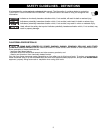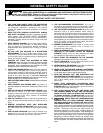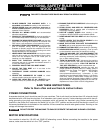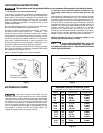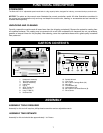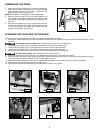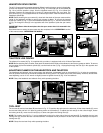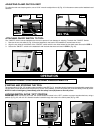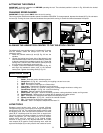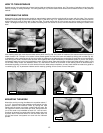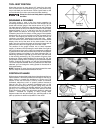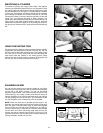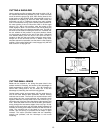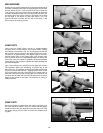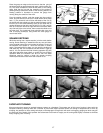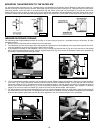
11
ACTIVATING THE SPINDLE
IMPORTANT: Unlock the spindle lock BEFORE operating the tool. The unlocked position is shown in Fig. 23A while the locked
position is shown in Fig. 23B.
CHANGING SPEED RANGES
IMPORTANT: Change speeds ONLY when the tool is running.
This tool provides variable rate spindle speeds from 600 to 2200 RPM. To change speeds, depress the release (A) Fig. 24 and rotate
the lever (B). Turning the lever clockwise increases the speed while turning it counter-clockwise decreases the speed.
Fig. 23A
Fig. 24
A
A
Fig. 23B
The tailstock will move slightly when it is tightened. To ensure
that the tailstock center will always be in line with the
headstock center:
1. Install the pointed centers (A) and (B) Fig. 25 into the
spindles.
2. Loosen the locking lever (back side of the tailstock), and
slide the tailstock (D) to the left until the tailstock center (B)
is almost contacting the headstock center (A). Tighten the
locking lever. Check to see if the tailstock center point (B)
is in line with the headstock center point (A).
3. To adjust, loosen the headstock locking shaft (C) Fig. 25,
and align the headstock center point to the tailstock
center point. Tighten the locking shaft (C) Fig. 25.
ALIGNING THE HEADSTOCK CENTER TO THE TAILSTOCK CENTER
B
A
B
D
C
Fig. 25
MACHINE USE
GLOSSARY
1. Beads - Rounded section between grooves.
2. Gouge Tool - (A) Fig. 26 - used mostly for roughing cuts and cove cuts.
3. Grind -Bevel part of a chisel.
4. Heel - The bottom of the angle on a Skew chisel.
5. Live center - Supports the workpiece on the tail stock.
6. Parting Tool - (C) Fig. 26 - used for cutting-off or making straight incisions or sizing cuts.
7. Round-Nose Scraper - (D) Fig. 26 - used for hollowing.
8. Shoulder - Edge of a groove in the workpiece.
9. Skew Chisel - (B) Fig 26 - used for smoothing cylinders, cutting shoulders, beads, and V-grooves.
10. SpindleTurning - Working with any material that is attached to the lathe centers.
11. Spur - Attaches to the work;piece and causes the workpiece to turn.
12. Square-end Scraper - (E) Fig. 26 - used for the outside of bowls.
13. Toe - The top the the angle on a skew chisel.
14. Vee-cuts - Cuts in a workpiece shaped like the letter “V”.
LATHE TOOLS
Standard wood turning tools come in several different
configurations (Fig. 26). The majority of turnings will require the
gouge tool (A) Fig. 26. This round nosed hollow chisel is used
for roughing cuts, cove cuts and other operations. The skew
chisel (B) is a double-ground flat chisel, with an angled end.
This tool is used for smoothing cylinders, for cutting shoulders,
beads, vee-grooves, etc. The parting tool (C) is a double-
ground chisel, used for cutting-off, or for making straight
incisions or sizing cuts to any required diameter. The round
nose scraper (D) is used for mostly hollowing work, while the
square-end scraper (E) is mainly used for the outside of bowls.
B D AAC
E
Fig. 26



